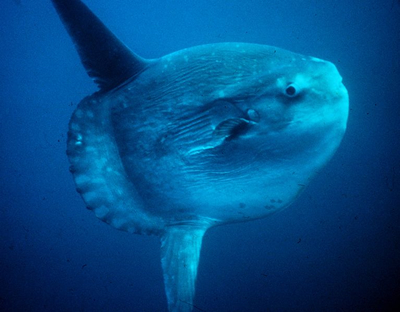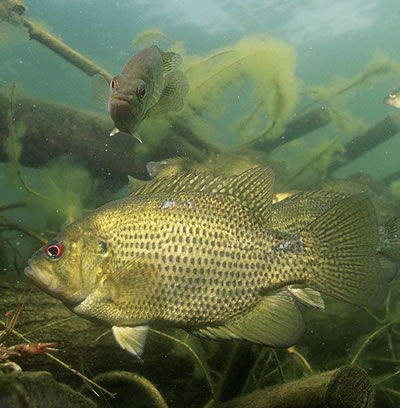Ray-Finned Fish

Facts about creatures
- Home
- Animal Classification
- Animal Habitats
- Amphibians
- Arthropods
- Bats
- Birds
- Carnivorans
- Cetaceans
- Chordates
- Crustaceans
- Dinosaurs
- Diprotodonts
- Elephants
- Fish
- Golden Mole
- Insects
- Lagomorphs
- Mammals
- Mammal Teeth
- Marsupial Mole
- Metamorphosis
- Mollusks
- Primates
- Reptiles
- Rodents
- Ruminants
- Soricomorphans
- Tenrec
- Tetrapods
- Vertebrates
Ray-Finned Fish
There are two kinds of bony fish living on Earth today – ray-finned fish (Actinopterygii) and lobe-finned fish.
Ray-finned fish derive their name from the bony spines or fin rays that support their fins.
These fin rays are sometimes known as lepidotrichia.
All bony fish – both ray-finned fish and lobe-finned fish have lepidotrichia.

However, lobe-finned fish also have fleshy lobes, which contain bone and muscle, at the base of their paired fins (pelvic and pectoral fins). Ray-finned fish lack these lobes.The lobes of a lobe-finned fish have the same structure as the limbs of tetrapods (four-limbed land vertebrates and animals that descended from four-limbed land vertebrates).
These lobes can swivel about in either a shoulder socket or a hip socket.
In a ray-finned fish, each paired fin is attached to the body by several bones and cannot swivel.
Ray-finned fish make up the majority of bony fish.
About 95% of all fish species and about half of all vertebrate species are ray-finned fish.
We know of almost 24,000 species of ray-finned fish.
Ray-finned fish can be found all over the world, in both freshwater and saltwater and in many different climates.
The largest living ray-finned fish on Earth that we know of today is the ocean sunfish (Mola mola), which can be up to 12 feet long and weigh over a ton.
The world’s smallest living ray-finned fish, and the world’s smallest living vertebrate, is believed to be Paedocypris progenetica. This fish, which belongs to the carp family, can be less than a third of an inch long.
Paedocypris progenetica was first identified in 2006.
The earliest fossils of ray-finned fish that we have found come from the Devonian period, which occurred from about 400 million to about 350 million years ago.

Respiration
Ray-finned fish usually live in water and use their gills to breathe oxygen that has been dissolved in the water.
Some species of ray-finned fish breathe air.
These fish use various organs – including modified swim bladders, modified stomachs, and modified intestines – to breathe air.
Swim bladders are air-filled organs that bony fish use to help keep themselves afloat.
Some air-breathing fish are obligatory air breathers. This means that they need to obtain oxygen from the air all of the time.
Others are facultative air breathers. They breathe air only when the oxygen level in the water becomes too low to support their metabolic needs.
Some ray-finned fish, such as the African butterflyfish (Pantodon buchholzi), come up to the surface of the water and take in oxygen from the air above the surface.
The African butterflyfish uses its swim bladder as a breathing organ.
Other air-breathing ray-finned fish, such as the walking catfish (Clarias batrachus), can move about on land when necessary. For example, if a walking catfish’s pond dries up it will travel over land to another pond. These fish will breathe air when they are on land.
The walking catfish breathes by means of a special organ that is known as a suprabranchial arborescent organ, which developed from the gill arches.
Although some ray-finned fish can walk and breathe air, tetrapods did not descend directly from ray-finned fish. Tetrapods are more closely related to lobe-finned fish.
Reproduction
Ray-finned fish may be oviparous – the females lay eggs outside of their bodies – or viviparous – the young develop inside of the female’s body.
Some ray-finned fish are ovoviviparous. This means that the eggs develop inside the mother’s body but the young do not get any nourishment directly from the mother. They get their nourishment from an egg yolk.
In some ray-finned fishes, such as seahorses, the eggs develop inside a pouch in the male’s body.
Perciformes – Perch-Like Fish

The largest and most diverse order of ray-finned fish, and of all vertebrates, is the Perciformes, or “perch-like fish”, which includes perch, bass, tuna, barracuda, groupers, porgies, angelfish, sunfish, damselfish, wrasses, gouramis and many other types of fish.
There are over 10,000 species of perciform.
They come in a wide variety of shapes and sizes.
Perciformes can be found all over the world. While most species live in the ocean, some can be found in fresh water.